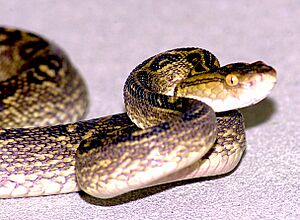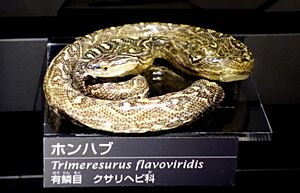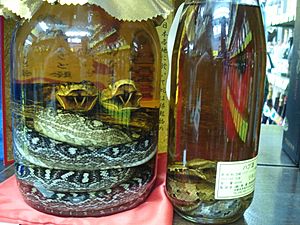Protobothrops flavoviridis facts for kids
Quick facts for kids Protobothrops flavoviridis |
|
|---|---|
 |
|
| Conservation status | |
| Scientific classification | |
| Synonyms | |
|
The Okinawa habu (scientific name: Protobothrops flavoviridis) is a type of pit viper snake. It lives only in the Ryukyu Islands of Japan. People there often call it "habu" or "Kume Shima habu." Sometimes, the name "habu" can also mean another snake, the Sakishima habu.
Contents
About the Okinawa Habu Snake

The Okinawa habu is the biggest snake in its group. It usually grows to be about 4 to 5 feet (120 to 150 cm) long. Some can even reach almost 8 feet (240 cm)!
This snake has a slender body and a large head. Small scales cover the top of its head. Its body color is usually light olive or brown. It has dark green or brownish patches that are long and stretched out. These patches have yellow edges and sometimes have yellow spots. They often join together to make wavy stripes. The snake's belly is whitish with dark colors along the sides.
Where the Habu Lives
The Okinawa habu is found only on the Ryukyu Islands in Japan. These islands include Okinawa and the Amami Islands. It is common on the larger islands that were formed by volcanoes. However, you won't find it on the smaller coral islands.
You can often spot this snake where palm forests meet farm fields. It also likes to hide in rock walls, old tombs, and caves.
Habu Snake Behavior and Life Cycle
Daily Habits of the Habu
The Okinawa habu lives on land and is mostly active at night. It often goes into homes and other buildings. It does this to hunt for rats and mice. This snake can be quite bold and quick to strike. It also has a long reach when it attacks.
How Habu Snakes Reproduce
Unlike most pit vipers, the habu lays eggs. Most pit vipers give birth to live young. Habu snakes mate in the early spring. They lay up to 18 eggs in the middle of summer. The baby snakes hatch after about 5 to 6 weeks. They are about 10 inches (25 cm) long when they hatch. They look just like the adult snakes.
Mongoose and the Habu Population
In 1910, a small animal called the small Asian mongoose (Herpestes javanicus) was brought to Okinawa. The idea was to help control the number of habu snakes. We don't know exactly how much this helped. However, bringing new animals to an area can sometimes cause problems for native birds, mammals, and reptiles.
Understanding Habu Venom
Being bitten by an Okinawa habu is serious. On the Amami Islands, about two out of every 1,000 people get bitten. The habu's venom is very strong. It can damage cells and cause bleeding.
If someone is bitten, they might feel sick to their stomach or throw up. Their blood pressure might drop. It's very important to get medical help right away. If a bite victim gets quick medical care, the bite is usually not deadly. However, about 6 to 8% of people who are bitten might have lasting problems. This could include losing some movement in their hands or legs.
Habu and Human Culture
On Okinawa Island, many habu snakes are caught. They are mainly used to make a special drink called habushu (ハブ酒). This drink is a type of liquor called awamori (泡盛). People believe it has traditional health benefits. You can buy it in bottles. Sometimes, a snake's body (or other animals like lizards or scorpions) is kept inside the bottle. Because of this, the habu has been hunted a lot for this traditional use.
See also
- Snakebite



